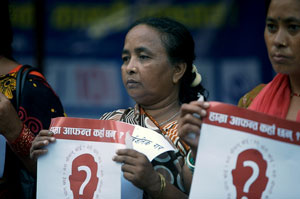 NEFAD |
As Nepal's entire system of governance creaks to the point of collapse, it may seem a strange time to go back to the conflict and ask about its victims.
But the problem with Nepal's politics is exactly that the legacy of violence remains unaddressed. Nepal's politics is the exclusive realm of parties that are top-down and undemocratic, with no accountability to their members, never mind their electors. This political culture allows the interests of ruled and rulers to be so divergent.
The history of efforts to address Nepal's violent past has been a stalemate, with no action taken for victims beyond a series of highly politicised payments that appear to be an effort to buy their silence. Victims of the conflict who have been most impacted by violations have been passive spectators to this non-process, objects of transitional justice rather than agents of it.
Civil society, supported by foreign donors, has been advocating a judicial process and truth about the past, but this had been done on behalf of victims rather than with them, emphasising and reinforcing the marginalisation that both facilitated violations and heightened their impact.
Human rights activism has come largely from the urban elite, while most victims of the conflict are poor and rural, with marginalised communities over-represented. After five years of advocacy a Truth Commission or an inquiry into disappearances, never mind a judicial process, seems as remote as ever. The end of the CA means the end for the moment of the struggle for legislative routes to truth, justice and reparation for victims.
The families of the disappeared are one of the defining legacies of Nepal's conflict and of the failure to address the violence of the past. More than 1,400 families still wait for news of loved ones missing from the conflict. In many districts families of the disappeared have come together to share their experiences, find solidarity and ways both to cope with the ambiguity of their loss and to campaign for an addressing of their needs.
In Bardiya, where more than 250 are missing, the Conflict Victims Committee (CVC) has brought families together in solidarity, making links to other organisations that can assist, offering financial support, campaigning locally and representing families in Kathmandu.
This represents an alternative modality for the fight for their rights to that of a civil society largely based in the capital, with victims representing themselves as part of a democratically constituted membership organisation that can reflect their own hopes and ambitions. CVC has been joined around the country by other district Family Associations, all rooted in their communities and seeking to make a difference for families where they are and on their terms. The impact they are having is significant, not just in addressing the emotional and social challenges families face, but achieving reconciliation across the divides of the conflict as victims realise their shared interests.
To have a voice in Kathmandu, 25 district Family Associations of the disappeared have come together as the National Network of Families of the Disappeared and Missing (NEFAD) to gain a national presence. Their aim is to show that dealing with the past is not something confined to the capital, but must be done in the rural communities where conflict was most intense.
The impact of mobilisation can be dramatic: Family Associations have seen family members from the most disempowered sections of Nepali society, Janajatis, Dalits, Madhesis, and above all women, radically changed by their participation. One woman described herself as 'transformed by action' through her engagement with her local Association. Such activity is socially transformative, challenging the traditional roles that women and others play in society and the stigma that has resulted from their sons and husbands being missing.
Poverty characterises the lives of most victims, worsened by the loss of breadwinners. How can a woman doing daily labour to feed her children be expected to sacrifice a day's wages to attend a meeting or hold a placard outside the CDO office? As a result, the leaders of the Family Associations are predominantly men, despite most active members being wives and mothers of the disappeared. Livelihood issues must therefore be addressed first.
The challenge now is for donors who constantly talk of their commitment to building peace in Nepal, but who have to date largely ignored victims and their organisations, to show their support to ensure that those most affected by Nepal's conflict can play a role in addressing its legacies.
Simon Robins has worked with conflict victims in Nepal since he worked with the International Committee of the Red Cross in Nepalganj from 2005-7.
Read also:
Truth without justice is an insult, ROBERT GODDEN
Forgotten futures, RAM KUMAR BHANDARI
The focus on the constitution has taken attention away from the plight of the families of the disappeared
The politics of memory, RAM KUMAR BHANDARI
On the 15th anniversary of the start of the war, relatives of the disappeared still wait for answers
See also:
The next People's War?, SIMON ROBINS in BARDIYA
A significant faction of the Maoist party remains committed to armed revolution



